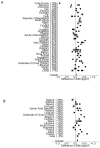The worldwide association between television viewing and obesity in children and adolescents: cross sectional study
- PMID: 24086327
- PMCID: PMC3783429
- DOI: 10.1371/journal.pone.0074263
The worldwide association between television viewing and obesity in children and adolescents: cross sectional study
Abstract
Background: Studies exploring the effect of television viewing on obesity throughout childhood are conflicting. Most studies have been confined to single high-income countries. Our aim was to examine the association between television viewing habits and Body Mass Index (BMI) in adolescents and children in a multicentre worldwide sample.
Methods: In the International Study of Asthma and Allergies in Children Phase Three, adolescents aged between 12 and 15 years completed questionnaires which included questions on television viewing habits, height and weight. Parents/guardians of children aged between 5 and 8 years completed the same questionnaire on behalf of their children. The questionnaire asked "During a normal week, how many hours a day (24 hours) do you (does your child) watch television?" Responses were categorised as; "short" (<1 hour), "moderate" (1 to ≤3 hours), "long" (3 to ≤5 hours) and "prolonged" (>5 hours).
Findings: 207,672 adolescents from 37 countries and 77,003 children from 18 countries provided data. Daily television viewing in excess of one hour was reported in 89% of adolescents and 79% of children. Compared with adolescents in the short viewing group, those in the moderate, long and prolonged groups had BMIs that were 0.14 kg/m(2), 0.21 kg/m(2), 0.30 kg/m(2) and 0.08 kg/m(2), 0.16 kg/m(2) and 0.17 kg/m(2) larger for females and males respectively (both P<0.001). Compared with children in the short viewing group, those in the moderate, long and prolonged groups had BMIs that were 0.24 kg/m(2), 0.34 kg/m(2), 0.36 kg/m(2) and 0.19 kg/m(2), 0.32 kg/m(2) and 0.36 kg/m(2) larger for females and males respectively (both P<0.001).
Interpretation: Increased television viewing hours were positively associated with BMI in both adolescents and children with an apparent dose response effect. These findings extend the evidence that television viewing contributes to increased BMI in childhood.
Conflict of interest statement
Figures




References
-
- Report of a WHO consultation. World Health Organ Tech Rep Ser. (2000) Obesity: preventing and managing the global epidemic. 894: i-xii, 1–253. - PubMed
-
- Popkin BM, Gordon-Larsen P (2004) The nutrition transition: worldwide obesity dynamics and their determinants. Int J Obes Relat Metab Disord 28 Suppl 3S2–9. - PubMed
-
- Hossain P, Kawar B, El Nahas M (2007) Obesity and diabetes in the developing world – a growing challenge. N Engl J Med 356: 213–215. - PubMed
-
- Hedley AA, Ogden CL, Johnson CL, Carrol MD, Curtin LR, et al. (2004) Prevalence of overweight and obesity among US children, adolescents, and adults, 1999–2002. JAMA 291: 2847–2850. - PubMed
Publication types
MeSH terms
LinkOut - more resources
Full Text Sources
Other Literature Sources
Medical

